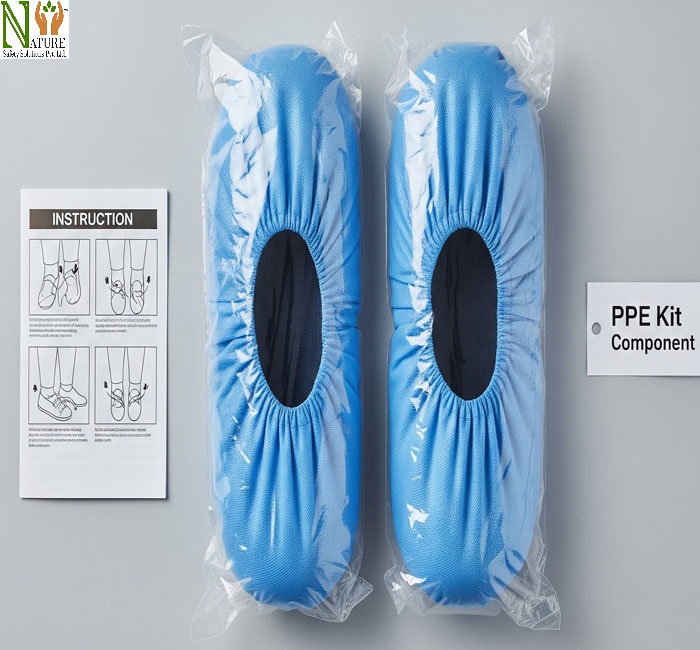In any workplace where hygiene, safety, or contamination control is a priority, personal protective equipment (PPE) plays a vital role. While gloves, masks, and gowns are the most visible parts of PPE, there’s one item that often goes unnoticed but is just as important – shoe covers.
These simple, lightweight accessories form a protective barrier between your footwear and the environment, helping to reduce the spread of dirt, germs, and hazardous substances.
Let’s explore how shoe covers work, the benefits they offer, and why they are essential in many professional settings.

What Are Shoe Covers?
Shoe covers are coverings made from materials like polypropylene, polyethylene, or non-woven fabric, designed to fit over regular footwear. Their purpose is to prevent anything on your shoes-from dirt to bacteria—to be transferred to clean or sterile areas. They’re usually disposable but can also be made from stronger, reusable materials for heavy-duty tasks.
They may look simple, but shoe covers play a powerful role in protecting both people and environments from invisible threats.
Why Shoe Covers Are Important
Shoe covers do more than just keep floors clean—they contribute to overall health, safety, and hygiene in multiple ways:
1. Protecting Clean Environments
In places like hospitals, food processing units, and pharmaceutical labs, keeping the environment sterile is essential. Shoe covers prevent the transfer of bacteria, dust, and dirt from outdoor footwear into these controlled settings.
2. Safeguarding the Wearer
In industrial settings, chemicals, oils, or biohazards may be present on the ground. Shoe covers offer an extra layer of protection between hazardous materials and the person wearing them.
3. Meeting Safety Standards
Many industries follow strict safety protocols enforced by organizations such as OSHA or CDC. Wearing PPE, including shoe covers, is often a legal requirement for maintaining workplace safety.
4. Avoiding Cross-Contamination
When professionals move between rooms or zones—like from a hallway into an operating room—shoe covers help limit the movement of germs or particles between spaces.
5. Keeping Floors Clean and Damage-Free
Shoe covers help prevent floor damage in sensitive areas like cleanrooms, laboratories, and newly constructed homes. They keep mud, water, and debris out of spaces where cleanliness is a top priority.
Types of Shoe Covers
There are different kinds of shoe covers to suit different tasks and industries:
• Disposable Shoe Covers
Lightweight and breathable, these are used in medical, research, and hospitality settings. They are worn once and then discarded to maintain hygiene.
• Waterproof Shoe Covers
These are made to resist liquids like water, chemicals, or bodily fluids. They’re useful in cleaning jobs, industrial spaces, or during rainy conditions.
• Non-Slip Shoe Covers
Fitted with textured soles, these help reduce the risk of slipping on smooth or wet floors—especially in hospitals, labs, or food facilities.
• Reusable Shoe Covers
Made from durable materials such as rubber or vinyl, these are suitable for long-term use in construction, maintenance, and hazardous waste areas. They can be cleaned and used multiple times.
Industries That Use Shoe Covers
Shoe covers are important in many workplaces. They help maintain cleanliness, protect surfaces, and ensure safety. Here are some industries where shoe covers are used every day:
- Healthcare
Doctors, nurses, and hospital staff wear shoe covers to keep patient areas clean. This helps prevent the spread of germs and infections. - Laboratories
In labs, cleanliness is very important. Shoe covers stop dirt from getting in and protect sensitive tools, samples, and experiments. - Manufacturing and Cleanrooms
In electronics, pharmaceuticals, and other high-tech industries, even tiny dust particles can cause problems. Shoe covers help keep these cleanrooms safe and controlled. - Cleaning and Janitorial Services
Cleaning staff wear shoe covers when entering freshly cleaned spaces. They also use them during pest control or deep cleaning to avoid spreading dirt. - Home Services and Construction
Workers like painters, electricians, and plumbers wear shoe covers in homes to protect floors from dust, mud, or paint stains. It shows care and respect for the client’s space.
How to Use Shoe Covers Correctly
To make sure shoe covers are effective, they must be used properly. Follow these best practices:
- Always put on shoe covers before entering clean or controlled areas.
- Dispose of them immediately after use—especially if they are contaminated or wet.
- Do not reuse disposable covers.
- Replace torn or damaged covers right away.
- Choose the right size to ensure a snug and secure fit.
Environmental Impact and Eco-Friendly Options
As disposable PPE use grows, concerns about waste have increased. Many manufacturers now offer eco-friendly shoe covers made from biodegradable or recyclable materials. In addition, some organizations are turning to reusable models to reduce long-term waste and costs.
By choosing the right type of shoe cover and disposing of it responsibly, organizations can balance safety and sustainability.
Also read:-
- Understanding PPE Masks and Respirators for Maximum Safety
- Complete Guide to PPE Kit Head Covers: Uses, Benefits, and Types
- PPE Kit Face Shield or Goggles: Essential Eye and Face Protection
- The Role of PPE in Industrial Safety
- OSHA’s New PPE Requirements for Construction: What You Need to Know Now
